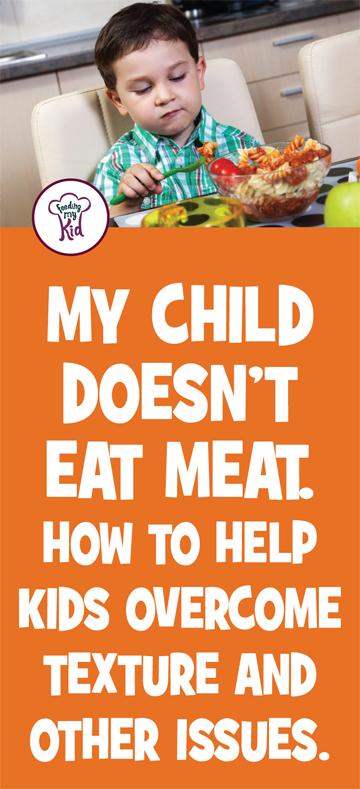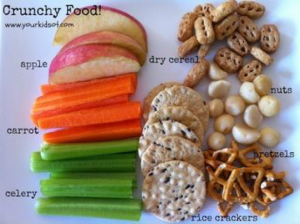 Realizing that your child doesn’t like meat can be stressful. Picky eating habits can add to that stress. Like any parent, you want what’s best for your child and you want him to be healthy. At what point does selection turn into picky eating?
Realizing that your child doesn’t like meat can be stressful. Picky eating habits can add to that stress. Like any parent, you want what’s best for your child and you want him to be healthy. At what point does selection turn into picky eating?
You may be wondering if it’s healthy for your child to boycott meat. The simple answer is yes. If your child eats a well-balanced diet (besides his meat-aversion) your child is very likely getting enough protein.
When I would hear this advice, I would always wonder, “How do I know if my child is eating a well-balanced diet?” In this article, we’ll help you evaluate what your child is eating and figure out if it’s well-balanced.You’ll also learn what might be causing picky eating. Picky eating can be a challenge, but with these tips, you’ll be able to stave it off. Plus, you’ll get tons of tips on how to encourage your child to be a more adventurous eater and nix that picky eating.
Check Out More Here:
- Differences in Baby Food Stages and Puree Texture
- Overcoming Food Texture in Kids
- Sweet Potato Risotto. The Perfect Passover Dish
Dairy Has Tons of Protein
Does your child consume diary which can include yogurt, cheese, ice cream, cottage cheese, or milk? If so, then he is probably reaching his recommended daily value of protein (1).
Most kids are consuming too much dairy. Find out how much dairy your child should have in a day.
Greek yogurt can have 10-17 ounces of protein in a serving depending on the brand and serving size. I add a little almond butter (which has protein, too) to our Greek yogurt and it turns into a delicious snack. The almond butter sweetens up the Greek yogurt and adds a little protein.
It’s rare for children to suffer from protein deficiencies in the United States because much of the food children eat are rich in proteins; there are few cases in the developed world where there’s concern for children not getting enough protein unless they have an allergy to milk (2)
Many Foods with Protein:
Outside of dairy, other foods high in protein include fish (salmon, tuna, and sardines), shellfish, tofu, beans, lentils, quinoa, goji berries, eggs, nuts, and seeds. Even bread can have protein in it.
Did you know avocados, potatoes, broccoli and peas all have protein in them, too? There’s even pea protein you can turn into a protein shake!
How Much Protein Does Your Child Need?

Check out this article awesome protein infographic:
To be certain, here’s how much protein children should have.
One to 3 year-olds need about 0.55 grams of protein per pound of their weight (3). That means a kid that weighs 40 pounds needs about 22 grams of protein a day. If your child is drinking 16 ounces of milk a day (the recommended amount) then your child is getting 16 grams of protein just from their milk and only needs to make up the additional 6 grams with other foods.
Four to 6 year-olds need about half a gram of protein per pound (3). An 80-pound child needs 40 grams of protein a day. If your child is drinking 20 ounces of milk a day (the recommended amount) then your child is getting 20 grams of protein just from their milk and only needs to make up the additional 20 grams with other foods.
Seven to 14 year-olds need 0.45 grams of protein per pound of weight (3). Generally, at this age, milk consumption goes way down and sugary drink consumption goes way up. Sugary drinks often do not have any protein. It’s essential you help your child navigate their teenage years with healthy eating advice and easy access to healthy meal and snack options at home and at school. Your child will need about 46-52 grams of protein per day.
Through this, we hope you’ve been reassured that your child is getting plenty of protein.
Even though your child is probably getting the necessary amount of protein a day, there are things you can do to help your child overcome his meat aversion. Let’s dig into how to help your child overcome their sensitivity to meat.
Why Do Kids Have Issues Eating Meat?
Let’s dig into the underlining reason for your child’s picky eating. Let’s start by answering these questions?
- Does your kid not eat any meat?
- Does he eat some meat?
- What type of meats does he eat? Document all the different types of meats, preparations and textures your child is eating.
Download the Gateway Food Tracker Chart from Feeding My Kid so you can start tracking what your child is eating. This is how you will be able to build on the foods your child is already eating and negate the picky eating habits.
You see, some adults and kids have texture issues and sensitivities. Food aversion, no matter the circumstances, can last a long time, especially if left untreated. This can result in picky eating that lasts a lifetime.
Maybe your child can eat chicken, but not steak. And, maybe he’ll tolerate ground beef. So why not try ground turkey instead of beef in a recipe? By documenting what types of meats your child eats, you will figure out what foods to offer next. Check out our food chaining video to learn more on how to do this.
Weak Jaw Might Be Causing Your Child’s Aversion to Meat
Your child may have jaw weakness. Some characterizations of picky eating can be on display because your child has not developed strength in their jaw or your child had not developed tongue lateralization (4).
If you think about what your child eats over the course of a week, does your child eat enough hard-to-chew foods? Sometimes, in our effort to reduce our child’s choking risk, we end up missing an opportunity for our child’s jaw to strengthen.
If you are steaming his vegetables and cutting up everything into very small pieces, then your child’s jaw may not be getting the exercise it needs to grow stronger. This can be another reason why some kids reject meat.
If your child eats chicken nuggets and not other meats then that might be telling you that you need to work on your child’s jaw strength. Chicken nuggets are processed, soft to chew and bland. The first time I made homemade chicken nuggets I was surprised to learn that I needed to put the raw meat into a food processor to turn it into a puree and then make nuggets out of it. I had no idea! Chicken nuggets do not require a strong jaw.
Since then, I still make homemade breaded chicken, but I serve whole pieces of chicken cut up versus pulverized chicken.
How to Improve Jaw Strength
One of my twins had a very weak jaw. We saw an Occupational Therapist because my son was chipmunking his food and not swallowing it. He would pack his cheeks full of food and then spit everything out.
We were tasked with exercises to help improve his jaw strength. I also brainstormed some foods that my son loved to eat that required more chewing and made sure he had ample opportunities to improve his strength.

This image features a number of harder to chew foods.
My twins love to eat dried and dehydrated fruits and veggies. These foods can be extremely chewy.
Have you tried offering a dehydrated piece of mango? These are large slices of mango that have been dehydrated. Now, that requires some chewing! Costco has some great options.
Get creative and challenge your child within his or her limits. Make this fun for him. Even fruit rollups can be a good practice food. I like to make my own and skip the preservatives and food coloring.
Start brainstorming some foods that your child eats that may require more chewing and make an effort to offer those foods more often until you start to see improvements.
If you’re worried your child has a jaw strength issue, you may want to schedule an appointment with an Occupational Therapist. Learn more about occupational therapists.
So as you can see, texture can be an issue.
Texture Issues Can be Contributing to Why Your Child Isn’t Eating Meat
Texture is one  of the major reasons why kids don’t eat meat. Meat can be chewy and hard to swallow. One way to get kids to be open to trying new foods is to change the texture and preparation to make it easier for kids to eat meat. Sometimes, the texture of foods can contribute to picky eating problems.
of the major reasons why kids don’t eat meat. Meat can be chewy and hard to swallow. One way to get kids to be open to trying new foods is to change the texture and preparation to make it easier for kids to eat meat. Sometimes, the texture of foods can contribute to picky eating problems.
Children can have adverse reactions to foods that have textures they don’t like. It all comes down to the presentation and the preparation of foods (5).
Whether kids enjoy crunchy textures, like fried foods; moist textures; or textures that are crispy, you can make sure foods that they don’t like, like meats, are made in the textures they do like. This is where a panko crusted chicken cutlet might be more appetizing to a child who loves crispy foods rather than just chicken breast.
Picky Eating Strategies to Try at Home
Bake some chicken with breading on it to give it that distinct, crunchy fried taste. Cook a steak with a mushroom sauce, tenderize the steak before cooking it or even try marinating it, which also helps to break down the fibers to make it easier to chew.
Have you tried shredding the meat instead of serving it in pieces? Stewing meat can soften the meat where it virtually melts in your mouth.
You don’t need to be a culinary genius. I just Google it when I’m unsure, and watch YouTube videos when I need to learn a new technique. Also, feel free to ask questions in our Facebook group.
There are tons of ways to change texture and make food more enjoyable for your kids.
Other Solutions:
-
-
-
 Serve up preparations in different ways. As mentioned, if your kid doesn’t like chicken and will eat ground beef, then try serving ground chicken. Don’t limit yourself. You can offer soups with meat and stews with meat. You can feed him pulled pork or chicken; sausages, hot dogs and meat sauce with pasta. You may want to ground up the meat in your sauce even more and add in a little meat slowly to get your child accustom to eating it. Think of it as slowly conditioning your child; you want to work at his pace.
Serve up preparations in different ways. As mentioned, if your kid doesn’t like chicken and will eat ground beef, then try serving ground chicken. Don’t limit yourself. You can offer soups with meat and stews with meat. You can feed him pulled pork or chicken; sausages, hot dogs and meat sauce with pasta. You may want to ground up the meat in your sauce even more and add in a little meat slowly to get your child accustom to eating it. Think of it as slowly conditioning your child; you want to work at his pace.
-
-
-
-
-
- Deconstruct your food. Many small children struggle with indiscernible foods. These are foods where a child cannot easily tell what is in them—think of casseroles. We know as adults, casseroles are delicious, but for kids, they don’t have those years of experience eating them to know how yummy they can be. The great news is that eventually if the casseroles are offered enough, your child will eventually learn to love them.
-
-
-
-
- Keep offering meat. Keep offering meat in a variety of preparations. Exposure is key to helping kids become comfortable with food. Kids may not eat it, but like with fruits and veggies, exposure never hurts — in fact, it helps. Expose them to these foods over and over again and be sure to be a good role model. Eat the foods yourself.
-
-
-
- Change the shape of food. Yes, changing the shape of some foods into foods your kids already like can help. If turning carrots into fry sticks can help kids eat carrots (it does work, try it!) then the same can go for different types of foods, like meats. Switch up the shapes (that’s why dinosaur chicken fingers sell).
-
-
-
-
-
- Cut a big chunk of meat and let your kid play with it. Let your kid suck on it and taste it. He may not be ready to eat it, but let him experience it. Cut up the meat into the size of a large steak fry. If you notice your child is taking bites off, then keep an eye to see what size bites your child is taking. If you’re concerned, then cut up the meat into smaller pieces.
-
-
-
-
-
-
- Don’t force your child to eat. This will cause more strife at the dinner table and may prevent your child from eating. Your child must learn to like the food on his own without outside pressure.
-
-
-
-
- Experiment with dips. Have your child dip some chicken fries into ketchup or dip some steak into Ranch. Whatever the preference is, try dips. They’re fun and will get your children trying out new foods. Check out our mega list of dip ideas.
-
-
- Toppings Bar. Let your kids be in charge of what they want. Have them pick from a variety of foods and meats to serve themselves. Sometimes, just handing control over to your child to serve himself can be the reason your child tries a new food. Check out how to make topping bars.
-
 Put it on a stick. This one is simple. Kids love when you put things on a stick. Toothpicks are also a great option to try too. My twins love to eat chicken on a stick.
Put it on a stick. This one is simple. Kids love when you put things on a stick. Toothpicks are also a great option to try too. My twins love to eat chicken on a stick.
- Make Food Fun. Why not make food fun by doing things like dips or topping bars or cutting up meat into fun shapes? By making food fun, kids will drop their guard and will be more likely willing to try the meats. Have a picnic with your child.
Just like with getting your picky eating eater to eat fruits and vegetables, there are plenty of creative ways to encourage your child to eat meat. Whether your child has an aversion to eating meat because of texture or because of the taste, there are fun, exciting and creative ways to get your kids eating meats without causing dinnertime strife.
Try a few of these suggestions or try them all. Each child is different. We hope to hear that your child is more open to trying new types of meats.

Citations:
-
Food and Nutrition: What Should I Do if My Child Won’t Eat Meat?
-
National Center for Biotechnology Information: Kwashiorkor in the United States: fad diets, perceived and true milk allergy, and nutritional ignorance.
-
Live Strong: Protein Intake For Kids
-
Day2DayParenting: Oral Motor Skills
-
Your Kid’s Table: How To Get Your Kid To Eat Meat

